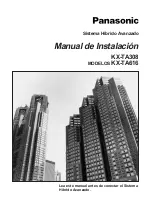
MAN#650598
Troubleshooting guide:
Problem
Possible cause(s)
Possible
Solution(s)
Sensor(s) do not show on
gauge readout.
BIM will not light up at all.
PWR terminal does not have power.
GND terminal does not have a good
ground.
Connect to a location that has power.
Connect to a different ground location.
Return for service. (see instructions).
Sensor does not show on
gauge readout.
BIM has a steady dot lit.
is displayed for
Channel Status (Trouble-
shooting Quick tips).
Interface harness is not connected.
Interface harness is loose.
Another BIM is set to the same channel
ID.
indicates a bus ID conflict.
Connect the supplied data harness between the BIM unit and the
gauge control box.
Make sure both ends of the cable are seated in securely.
Test that module works when connected to control box alone.
Use the Auto ID Setup (Special Operating Mode “
”) to change IDs.
Gauge lights up, but does
not read pressures.
One or more sensors reads
on Tire PSI screen.
Sensors have not woken up.
Voltage or wiring problem in the vehicle
wiring harness.
Drive vehicle until sensors wake up and tire pressure is displayed.
Change the associated tire’s pressure by inflating or deflating with a
pressure change of more than 2 PSI.
Check wiring harness for loose or damaged wires.
One or more sensors reads
on Tire PSI screen
after extended period of
driving time even though
tire does have pressure.
TPMS Receiver Module is not receiving
from the TPMS sensors
Sensor needs to be “learned”
If a sensor functioned previously but now
it never wakes up, it is possible its
battery has depleted.
Try moving the TPMS Receiver Module to a location outside the vehicle
to see if it receives from the TPMS sensors.
If a
sensor needs to be “learned”, follow
BIM Learn Sensors
Mode
in the section
Special Operating Modes
to relearn the sensor(s).
Follow
-
Display Battery Status Mode
in the section
Special
Operating Modes
to determine the sensor’s battery status.
If sensor is still not detected, order replacement sensor(s) (see
instructions).
Gauge repeatedly displays
then
on all 4
Tire PSI locations.
BIM repeatedly displays
then
.
This error is a result of the TPMS
Receiver Module not being detected by
the BIM-22-2 on power up.
TPMS Receiver Module is not connected
to the BIM.
TPMS Receiver Module is damaged.
Connect Input on BIM to TPMS Receiver Module (see wiring diagram).
Inspect and reconnect wires and power up again.
Return TPMS Receiver Module for service. (see instructions).
BIM repeatedly displays
then
.
This error message occurs when the
BIM-22-2 does not receive vehicle speed
from a control box or a BIM-01-2.
If this is displayed when the control box
gauge is not in the SETUP menu, the
BIM to control box interface harness is
not connected or it is loose or faulty.
Note that this BIM display message will occur on VHX, VFD3, and
VFD3X systems during the locate procedure because those systems
do not send the vehicle speed while in the SETUP menu. This is
normal and no solution is necessary.
Inspect and reconnect interface harness.
Replace TPMS Receiver Module interface harness.
Gauge displays
“FILL LOW TIRES” during
locate procedure
One or more TPMS sensors need to be
woken up.
One or more tires do not have more than
20 PSI in them.
Inflate all tires with a 2 PSI change in pressure to wake up all sensors.
Inflate all tires until all of them contain more than 20 PSI.
Number of missing sensors
is not correct during the
BIM Learn procedure.
System could be receiving from one or
more of the sensors being replaced.
Remove the senor(s) being replaced from the area of the vehicle.
Audio alarm (HDX only) is
not heard during:
Gauge LOCATE procedure
or
BIM Learn procedure
or
BIM Locate procedure
Alarm is not connected to the gauge
cluster.
Gauge cluster is in SETUP menu.
Ensure alarm harness is connected to gauge cluster.
Exit the SETUP menu.
Tire pressure values do not
agree with the location
indicated on the
instrument
’s TIRE PSI
screen.
Sensors were installed in wrong location.
Locate procedure was not followed after
a tire rotation.
Follow the gauge system
’s locate procedure or the BIM locate
procedure.
Valve stem is damaged but
sensor is OK.
Valve stem damaged during installation
or during operation.
Order replacement valve stem(s) (see instructions).


























